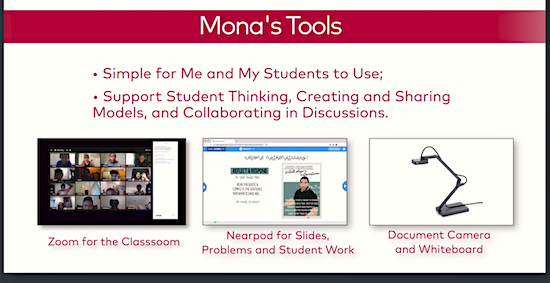Deep Learning Strategies for Online Math Classes
By Mona Iehl
 Teaching during the pandemic has forced me to make decisions about what matters most. While designing my online classroom for this school year, I looked back to what worked in the physical classroom and prioritized my values.
Teaching during the pandemic has forced me to make decisions about what matters most. While designing my online classroom for this school year, I looked back to what worked in the physical classroom and prioritized my values.
Doing this made it clear to me that certain things – like spending time developing a strong community of learners that allows for students to explore math by sharing their thinking through discussions – were essential whether in person or remote.
But realizing that I couldn’t just apply the structures that worked in person through the computer screen, I set out to apply my prioritized values in the online classroom.
Along the way, I found five key strategies that have helped me promote deeper learning in my online math classroom. Here they are, along with a video showing some of these strategies “in action” with my students.
#1 Choose the right tools
I spent several weeks playing around with many tech tools at the onset of online learning. In the end, I settled on a few that I really love. These are the three things I look for in a tech tool:
1. I can see all students’ work in real time.
2. Students can draw/write on the slides easily to show their math thinking.
3. The tool is simple to use for students and myself.
I found that Nearpod best fits the criteria I was looking for; however, it’s not the only tool that can work to achieve deeper learning online. The one thing I have learned is that the tech tool has to be right for YOU, the teacher, first.
Your confidence and execution of the tech tool will be integral to your students’ ability to adapt and learn to use it. Start with a tool you really like using and know well. Then, venture out and find another tool that might fit some your needs. Among my favorite tech tools are Jamboard and Padlet as well as Nearpod.
In the video above, which documents how I approach deeper learning in my online math classroom, at minute 1:39 you can see me using the Nearpod app to view my students’ work.
#2 Maintain clear expectations
Clear expectations lead to confidence and clarity in the classroom. Students know what to expect and what is expected of them, and this helps them make decisions independently.
In my classroom I spend 3-5 minutes every day making sure each student knows what is expected of them. We have three clear Habits of Work that guide how we do our work each day. At the onset of our lesson we spend time talking about what it looks like and sounds like to participate (see 1:28 in the video.)
This empowers my students to be active members of the class and their learning because they know exactly what is expected of them. Students don’t have to question “What should I be doing right now?” Instead, they can focus on meeting the expectations to the best of their ability.
Deeper learning happens when students feel like they are part of something, when their work matters, and when they have a sense of belonging. One of the first steps in developing a strong classroom community is through establishing clear expectations.
#3 Simplify lesson designs to ensure deeper learning
There are a lot of things we cannot control in online learning, but what I can control is the predictable structure of our daily time together. This is accomplished through a clear routine for my students to explore mathematics each day. When creating the routine for my online lessons, I simplified my in-person instructional moves to include only the lesson components that I value most: student discovery, math discussions, and establishing a strong classroom community.
Each day begins with students reflecting on a quote from a famous mathematician (see 1:24 in the video). This activity is my intentional olive branch to those students who find their strengths in language arts and don’t yet see themselves as mathematicians. Most importantly, these quotes help my students create their own definition and ideas about what it means to be a mathematician. Because, after all, as Marian Wright Edelman said, “You can’t be who you can’t see.”
The next part of our routine includes just two problems. For each problem we follow the same series of events (you can see this full sequence starting at 3:52 in the video):
✻ Launch the task
✻ Grapple time when students work independently
✻ A discourse about students’ strategies
This routine is simple and predictable, allowing my students to show up each day knowing what to expect. I want them to challenge themselves and take risks in their thinking. The routine provides the safe and predictable container where students can be critical thinkers, explorers, and risk takers.
#4 Get students talking (to each other, not just to teachers)
“Whoever is doing the talking is doing the learning” is on repeat in my head as I teach. As a talker, verbal processor, and a gal with the “gift for gab” from an early age, I could easily fill a 75-minute class just talking. I constantly have to remind myself that my students learn when they talk. I have found a few effective ways to get students talking.
✻ Use breakout rooms as virtual “turn and talks.” Students talk about what they notice about the math models and strategies. This serves as a “rehearsal” for the whole group discussion (see 7:18 of the video.)
✻ Call on students directly with “opt out” talking stems. Every student has a job to be thinking and ready to participate when called on. I give students the option to say “I’m not ready, yet. Can I call on _____, please.”
✻ Make the models clear so students can use evidence to discuss their thinking. I chart students’ models and strategies so that everyone can see the work. Then, students can refer directly to the math work, which keeps the discussions focused (see 5:48 of the video.)
Expect progress, not perfection. I don’t expect that my students will engage in one discussion and understand the math concepts. It’s an ongoing process – a progression – that students are moving along. Each day I work to encourage them and nudge them along this progression of understanding (see 8:29 of the video.)
#5 Create worthy math tasks that give students something to talk about
Choosing the right math to teach during online learning is essential to high engagement and deeper learning. It might seem like the right thing to assign practice problems and have students do as much practice as possible for every standard. After all, we don’t want them to fall behind.
However, I have found that choosing prioritized power standards has made the most impact on my students’ understanding. Once I have my power standards – those that, if missed, will affect students’ progression of understanding in years to come – I can create worthy math tasks.
What is a worthy math task?
✻ One that is open ended and allows for multiple ways to arrive at an answer.
✻ One that entices every learner to start with a simple entry point.
✻ One that has potential for extensions to challenge every student.
✻ One that gives students many ways to discuss mathematics.
I love using “Which One Doesn’t Belong” and “Problem of the Day” because these tasks allow students to grapple with a math concept and arrive at answers using different methods. This gives us a lot to debrief through discussion. My students can disagree, debate, and critique the reasoning of others because our math task is rich.
It’s not forever, it’s just for fun
Whenever there was a less than ideal situation growing up my mom would always say, “It’s not forever, it’s just for fun!” Thinking of these situations as fun kept us light hearted until we reached the eventual end.
Learning online might not be forever, but we can make the best of it and maybe even have some fun! In fact, I don’t think I’ll ever go back to “the way it was.” I have learned countless lessons about the value of technology and my students’ unbelievable abilities.
To simply return to normal would be impossible. So I’m going to continue to keep my values close to my planbook and make decisions based on what I know is best for students’ learning. Once we all finally return to the school building, I will likely be reflecting again, but this time I’ll be asking, “What worked in my online classroom that I can apply to my in-person class?
Mona Iehl (@LocalLearnersandCo) is a fifth- and sixth-grade math teacher at Polaris Charter Academy in Chicago, Illinois. Mona started her career 13 years ago teaching in the primary grades at Polaris but found her home in the middle grades five years ago. Mona recently took her passion for helping teachers and students find their inner mathematician to the blog world.


































This story hits home with the difficulties and flexibility that teachers had to show during the pandemic. It’s great that the focus is on keeping a strong sense of community and letting students discover maths through discussions. The suggested ways to encourage more in-depth learning in an online math lesson are useful and smart.